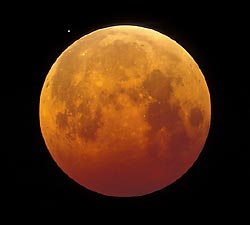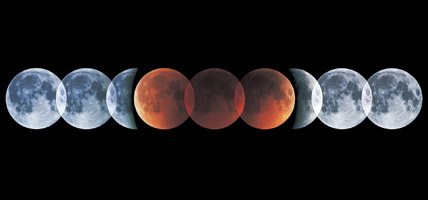May 7, 2003
Contacts:
Alan MacRobert, Senior Editor
855-638-5388 x151, [email protected]
J. Kelly Beatty, Executive Editor
855-638-5388 x148, [email protected]
Note to Editors/Producers: This release is accompanied by high-quality illustrations and an animation; see details below.
On Thursday night, May 15th, skywatchers throughout the Americas will have a front-row seat to the first total lunar eclipse in almost 2½ years — and the first visible across the US since January 2000. Moreover, most North Americans will see the event in prime time. As listed in the table below, the Moon will be totally eclipsed beginning at 11:14 p.m. EDT (10:14 p.m. CDT; 9:14 p.m. MDT; and 8:14 p.m. PDT); for West Coast observers, the Moon rises with the partial eclipse already in progress.
Skywatchers in western Europe and western and southern Africa will see the eclipse before and/or during dawn on Friday morning, May 16th. In the table, UT stands for Universal Time (Greenwich Mean Time).
| Total Eclipse of the Moon, May 15–16, 2003 | |||||
| Eclipse stage | UT | EDT | CDT | MDT | PDT |
| Moon enters penumbra | 1:05 | 9:05 p.m. | 8:05 p.m. | — | — |
| Partial eclipse begins | 2:03 | 10:03 p.m. | 9:03 p.m. | 8:03 p.m. | — |
| Total eclipse begins | 3:14 | 11:14 p.m. | 10:14 p.m. | 9:14 p.m. | 8:14 p.m. |
| Mideclipse | 3:40 | 11:40 p.m. | 10:40 p.m. | 9:40 p.m. | 8:40 p.m. |
| Total eclipse ends | 4:06 | 12:06 a.m. | 11:06 p.m. | 10:06 p.m. | 9:06 p.m. |
| Partial eclipse ends | 5:17 | 1:17 a.m. | 12:17 a.m. | 11:17 p.m. | 10:17 p.m. |
| Moon leaves penumbra | 6:15 | 2:15 a.m. | 1:15 a.m. | 12:15 a.m. | 11:15 p.m. |
A total lunar eclipse occurs when the Sun, Earth, and Moon form a straight line in space and the full Moon passes through Earth's shadow. Unlike a solar eclipse, which requires special equipment to observe safely, you can watch a lunar eclipse with your unaided eyes. Binoculars or a small telescope will enhance the view dramatically.
As the Moon moves into the outer fringe or penumbra of Earth's shadow, it will fade very slightly — imperceptibly at first. The real show begins when the Moon's leading edge enters the shadow's core, or umbra, and the dramatic partial eclipse begins. For the next hour and 11 minutes, more and more of the Moon will slide into dark shadow.
Total eclipse begins when the Moon is fully within the umbra. But it won't be blacked out! The totally eclipsed Moon should linger as an eerie dark gray or coppery red disk in the sky, as sunlight scattered around the edge of our atmosphere paints the lunar surface with a warm glow. This is light from all the sunrises and sunsets that are in progress around Earth at the time.
After 52 minutes the leading edge of the Moon will emerge back into sunlight, and the eclipse is again partial. In another hour and 11 minutes the last of the Moon emerges out of the umbra.
Details about this event, and how to enjoy it, appear in the May 2003 issue of Sky & Telescope magazine.
This year brings two total eclipses of the Moon. The second, on November 8th, will also be visible from North and South America.
Sky & Telescope is making the following illustrations and animations available to the news media. Permission is granted for one-time, nonexclusive use in print and broadcast media, as long as appropriate credits (as noted in each caption) are included. Web publication must include a link to SkyandTelescope.com.

A lunar eclipse occurs when the Moon passes through the shadow cast by the sunlit Earth. This shadow actually has two components: the outer, lighter penumbra and the inner, much darker umbra. When the Moon enters the penumbra, it becomes dimmer, though only slightly. Only when it passes into the umbra does it look markedly different. During a total eclipse the Moon does not completely disappear. Light from the Sun passes through Earth’s atmosphere and casts a reddish tinge upon the lunar surface. Diagram not drawn to scale. Click on the image to download a publication-quality JPEG (122 kilobytes) via FTP.
Sky & Telescope diagram by Gregg Dinderman.

A lunar eclipse occurs when the Moon passes through the shadow cast by the sunlit Earth. This shadow actually has two components: the outer, lighter penumbra and the inner, much darker umbra. When the Moon enters the penumbra, it becomes dimmer, though only slightly. Only when it passes into the umbra does it look markedly different. On the night of May 15th, the Moon passes through the northern section of the umbra and thus may not become completely invisible. Light from the Sun passes through Earth’s atmosphere and should cast a reddish tinge upon the lunar surface. Click on the image to download a publication-quality JPEG (141 kilobytes) by FTP.
Sky & Telescope diagram by Steven Simpson.

On September 26–27, 1996, Sky & Telescope senior editor Dennis di Cicco captured this image of a lunar eclipse at totality. The bright dot to the Moon's upper left is a background star in the constellation Pisces. Click on the image to download a publication-quality JPEG (4.1 megabytes) via FTP.
Sky & Telescope photograph by Dennis di Cicco.

Aligning his camera on the same star for nine successive exposures, Sky & Telescope contributing photographer Akira Fujii captured this record of the Moon’s progress dead center through the Earth’s shadow in July 2000. On May 15–16, 2003, another total lunar eclipse will be visible from North America. Click on the image to download a publication-quality JPEG (1.5 megabytes) by FTP.
Courtesy Akira Fujii and Sky & Telescope.

This 10-second-long animation of a total lunar eclipse consists of 291 individual black-and-white images taken on September 27, 1996. In this sequence, 1 second represents 30 minutes of elapsed time. Coloring has been added to simulate the Moon's appearance when it was completely within Earth's shadow (and it has been brightened for clarity). During this interval of total eclipse, or totality, dark, murky blobs are seen crossing the lunar disk — an effect caused by variations in the tiny amount of sunlight that leaks onto the Moon after being refracted through Earth's atmosphere. This can be viewed or downloaded as a broadcast-quality QuickTime movie (3.7 megabytes).
Sky & Telescope animation by Craig Michael Utter and Gregg Dinderman; images courtesy António Cidadão.
 0
0
Comments
You must be logged in to post a comment.